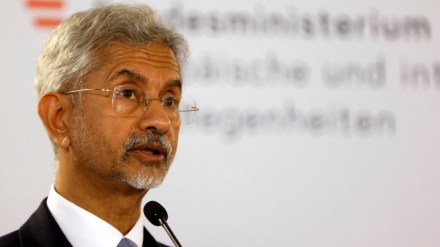The Quad, a diplomatic alliance between India, Japan, Australia, and the United States, continues to strengthen its position as a key player in global geopolitics. External Affairs Minister S Jaishankar at the India – Japan Forum today discussed the evolution of the Quad, its expanding agenda, and the challenges it faces, particularly in light of the upcoming Quad Leaders’ Summit, expected to be hosted by India in 2025.
Reviving the Quad: A Shift in Strategy
The minister reflected on the Quad’s origins, noting that the grouping was revived under the Trump administration. “The Quad was actually restarted by the Trump administration, and it began at the vice-minister level in 2017,” he said. He highlighted that in 2019, the alliance moved from a vice-ministerial to a foreign ministers’ level engagement, and by 2020, the Quad held one of the few in-person diplomatic meetings during the global lockdown in Tokyo. Jaishankar credited the Trump administration for giving the Quad a new lease of life, positioning it as a strategic initiative that has continued to grow under subsequent US administrations.
Today, the Quad has become a central mechanism for diplomatic engagement, transcending its initial focus on security to encompass a wide range of global challenges. Jaishankar noted that many US leaders, including Mike Pompeo and Tony Blinken, would cite the Quad as one of their major foreign policy achievements, underscoring its increasing importance.
A Fair Partnership: Addressing Burden-Sharing Concerns
One of the key aspects Jaishankar discussed was the cooperative nature of the Quad, particularly in relation to concerns about “burden-sharing.” In traditional alliances, there is often debate about the unequal distribution of responsibilities. However, Jaishankar argued that the Quad does not operate on this model. “In the Quad, everybody pays their fair share,” he said, likening the partnership to a dinner where all participants contribute equally. This structure ensures that each country shares the load in a manner that is comfortable and sustainable for all, allowing the Quad to avoid the pitfalls of other international alliances.
Expanding the Quad’s Global Agenda
While the Quad began primarily as a security-oriented grouping, its agenda has now expanded to address broader global challenges. Jaishankar emphasized that the Quad is not just about regional security but also tackles issues like climate change, technological innovation, and health security. “The Quad is one of the most expansive forms of intergovernmental coordination,” Jaishankar remarked, highlighting the breadth of its activities.
Looking ahead, the Quad Leaders’ Summit in 2025, which India is set to host, will be an opportunity to deepen this collaboration. The summit will focus not only on Indo-Pacific security but also on promoting economic resilience and global cooperation to address crises like climate change and health pandemics. As the Quad’s reach continues to grow, so too does its influence in shaping global norms and responses to emerging challenges.
India-Japan Relations: Shared Concerns and Opportunities
Jaishankar also discussed the growing relationship between India and Japan, noting that while both countries have maintained strong ties, there is always room for improvement. “We’ve never had problems between India and Japan, but not having problems doesn’t mean everything works well,” he stated, suggesting that the focus should now be on transforming positive sentiment into practical outcomes.
A significant part of their shared concerns lies in their proximity to China. Both India and Japan have experienced tensions with Beijing, particularly in relation to trade imbalances and territorial disputes. Jaishankar referred to India’s experience with China, explaining that while the two nations had a stable relationship for many years, the 2020 border clashes marked a turning point. “Our entire relationship with China was predicated on the fact that the border areas would remain peaceful and stable… In 2020, the Chinese chose to bring a lot of forces to the border areas,” he explained, acknowledging how this shift impacted India’s strategic outlook.
Tourism and People-to-People Engagement
Jaishankar also highlighted the increasing number of Indian tourists, noting that the demand for international travel has surged, with passport issuances growing by 10-15 percent annually. “We are issuing between 13 to 15 million passports every year,” he said, pointing out that foreign travel is becoming more common for Indians. However, he also noted that Japan has not yet fully capitalized on this trend, with Indian tourists preferring destinations in Southeast Asia, Europe, and the Gulf. “Indian tourists are really going there in very large numbers,” Jaishankar said, suggesting that Japan could benefit from strengthening its connections with India to tap into this growing market.
The China Challenge: Navigating Tensions
Jaishankar also addressed the ongoing tensions with China, particularly along the Line of Actual Control (LAC), where the 2020 clashes have led to years of diplomatic and military disengagement. “We still have challenges left with us… we have to sit down and discuss with China how we rebuild our relationship,” Jaishankar noted. While there has been progress in disengaging forces from the LAC, he made it clear that the situation is still complex, with further discussions needed to de-escalate tensions and rebuild trust between the two countries.
The Quad’s Future: A Growing Force in Global Affairs
Looking ahead, Jaishankar suggested that the Quad’s role will continue to evolve and expand. As the world faces growing geopolitical tensions and global challenges, the Quad is well-positioned to play a leading role in shaping global responses. “Meeting by meeting, quarter by quarter, year by year, the Quad is growing,” he said, reflecting the increasing scope and depth of the partnership.
With India set to host the Quad Leaders’ Summit in 2025, the Quad will further solidify its place as a central forum for cooperation on issues like Indo-Pacific security, global health, technology, and climate change.
